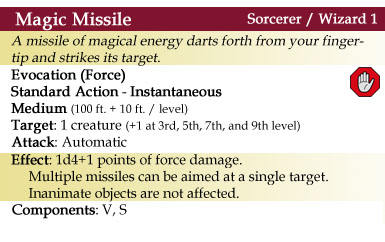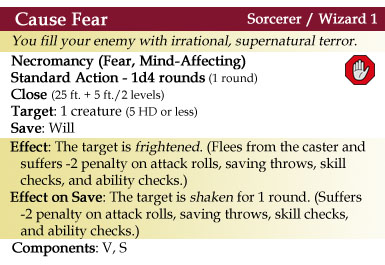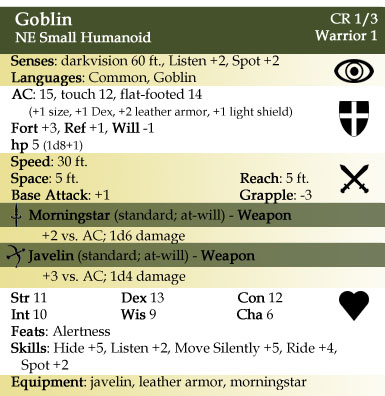Robert J. Schwalb has a post hypothesizing that 4th Edition would have been more widely accepted if it had been formatted differently.
Fourth edition’s presentation abandoned nearly everything familiar about the game’s look. Eight years of 3rd edition, I think, created strong expectations about how the game should read and since the game didn’t match the visual expectations, it certainly must not match the play experience.
He goes on to argue that 4th Edition wasn’t as big of a shift from D&D if you compare it to the proto-4th Edition supplements being published by Wizards in the last couple years of 3rd Edition (Tome of Battle, for example). This is true. But I think Schwalb is ignoring the fact that their proto-4th Edition supplements were bringing with them proto-4th Edition critiques even before 4th Edition was released.
Schwalb also includes a PDF of what 4th Edition powers might have looked like if they’d been formatted more like 3rd Edition spells and asks, “I wonder if those changes might have been more palpable had we shifted back toward the old presentation, even if doing so meant that the game would be harder to learn.”
I doubt it. Oh, I’ve seen some people comparing the new powers format to Magic: The Gathering cards and the like. But when you dig down into the real complaints people have about 4th Edition they tend to be either dissociated mechanics, abandoning the traditional D&D gameplay that existed from 1974-2008, dissatisfaction with the “miniatures are mandatory” combat, or some combination thereof.
Personally, I think 4th Edition has some great formatting. I’ve been completely sold on the idea that monster stat blocks should contain all the rules for running the monster since at least 2000 (when my earliest adventure prep notes for 3rd Edition prominently featured monster stat blocks modded to do just that).
So count me down pretty firmly in the camp of “I like the format, I don’t like the rules”.
And to that end, consider this small sampling of 3rd Edition wizard spells formatted with 4th Edition stylings:



(The red hand indicates that spell resistance applies.)
And here’s a 3rd Edition Goblin using a 4th Edition styled stat block structured similarly to my own revised stat blocks:

I doubt that such formatting would really have been a turn-off for anybody. (In fact, Paizo’s reformatting of spells for Pathfinder spells is not terribly dissimilar, albeit slightly more conservative.)
In fact, let me go one step further: Schwalb hypothesizes that 4th Edition might have been hurt by its radical formatting shift. I think the opposite is true. I think 4th Edition’s superior formatting has attracted people who would otherwise have stuck with 3rd Edition. Significant chunks of the utility 4th Edition gets praised for (like including all of the rules necessary for running a monster in the monster’s stat block) is stuff that can just as easily be done in 3rd Edition.












Still can’t stand the light-on-dark headers, nor the dark fadeout backgrounds. Colour coding things not great either (especially red/green).
I’m not sure that formalising the effect detail of spells works for me either. It’s playable, but I have to get people to play it first. The descriptions have traditionally been short on game mechanics for good reason. Hmm, there’s a good rant about emergent complexity in games hidden in there (which hides another about emergent simplicity).
Anyway, I too converted a few 3e monsters to that style of stat block when 4e came out, but wasn’t greatly happy with it. Good for detailing variants in a module format, but lacking a lot as a monster manual entry. Takes up too much page for what it presents too, but it’s tricky to compress.
I’m not quite sure if I would like that format for spells, but that red hand is … handy… ;P
But what me irked the most were the dissociated mechanics and nothing else. The preview of the Warlord or Warlock or whatever was my eye opener. This new edition wouldn’t work for me. And that’s the reason I play Pathfinder or older editions and not 4e. Surely not the formatting.
I agree, I actually find it hard to go back to the cluttered format of some of the older 3rd edition products.
That said, I do find that the way the powers are listed in the 4th Edition PHB in their color carded and damage formula glory, while very efficient, also has the unfortunate effect of emphasizing how boringly similar all those powers end up being (this power does 4W damage, and THIS one does 3W + 1 round status effect.) The occasional compact spell illustration (like in the 3rd edition spell section) might put a little more wonder back in the game, but as Jason points out, the root of the problem is the powers themselves are boring.
Using a goblin for this is cheating, try the barghest next. 🙂 I’ve tried noodling around with something similar over the past couple of weeks and found my biggest stumbling block with 3e monsters isn’t just the layout, but their huge laundry-list of spell-like abilities most of them have. 4e’s tricks for simpler game-play and prep aren’t just in layout, but also in how it distills monsters down to a set of core abilities usable during a fight.
@Jeffrey: If I were going to do the barghest, I’d first need to fix the barghest. Designing a monster so that you need to apply new HD to it in the middle of combat is just bad design. The only way I’d use a RAW barghest would be to prep a stat block for every possible HD so that I can just swap to the new stat block.
The thing that surprises me is that 3E’s designers knew this; that’s why they included a negative level template (-1 on all checks, -5 hit points, -1 effective level, lose your highest level spell and your highest level spell slot). It seems pretty obvious that the way to fix the barghest is to reverse that template: For each foe devoured, +1 on all checks, +5 hit points, +1 effective level, +1 caster level for spell-like abilities. After 24 hours the barghest can digest the soul energy and permanently raise their HD. (This could also be used to take the edge off “it fed on you, so you can’t be raised” ability: If you can kill the barghest before it digests the soul, you can raise the victim normally.)
Pathfinder’s fix is similar, although (IMO) more complicated than it needs to be because they don’t go for the “once you’re out of combat, just raise the HD properly”.
The shapechanging is interesting. I’ve previously simply prepped separate stat blocks for each shape (see my dire werewolf templates). But now I’m wondering if color-coding might work… Hmm.
http://imgur.com/HsAWN.png
I made one too. Hmm looks like your perfect system also suffered from disassociated mechanics you disingenuous grognard.
What you did with the goblin was not particularly original. Stat blocks of late 3E already looked that way. Though for more complex monsters, they did not (and indeed could not) put all relevant information in the stat block. Spells, feats and the like still had to be looked up.
@Red_Mage/Roxolan: You guys kinda have me scratching my head.
First, I’ve never claimed that 3rd Edition is “100% free of dissociated mechanics!”. Barbarian’s rage is a good example. Cure spells are another. I’m not sure why you feel it’s “disingenuous” for me to say something that you apparently agree with. People often utter this sort of thing as if it were some sort of “gotcha”; which it might be, if I had ever claimed that 3rd Edition had achieved absolute perfection or that all dissociated mechanics are of the devil and should be abolished.
Second, I explicitly said that the goblin stat block was based on a revised stat block that was based on late 3E stat blocks. When a guy cites his sources, I’m not really sure what the point is in saying, “You used those sources!” Well… yes. Yes, I did.
Also, think about trying to avoid the personal attacks, Red_Mage. At least until you can justify them with something more than crazy, fact-free accusations.
I think both you and Rob have a point here. If the 4e PHB had have been visually connected to 3e, it might have led to some players giving it a fairer shake. In the end though, the system has to stand on its play merits and that is something that has a lot of players divided. The classic mutton dressed as lamb as it were.
However, you also make an incredibly valid point that 4e formatting for stat blocks is an incredible leap forward and that having all a monster’s running information in one place makes a huge difference in DMing effectively. Looking at your Barghest/Balor stat block, it is clean but I think the 4e style fails to take in some of the nuances of 3e design. A slightly re-configured 4e stat block designed specifically for 3.x/Pathfinder/OGL would be excellent.
Best Regards
Herremann the Wise
Was there really so much similarity in formatting between AD&D, AD&D 2E and 3E/3.5?
@Brian
Yes, there was. The 2nd edition game simply built upon the 1st changing little in language. An organisation, errata and art shit made 2nd edition much more readable later on with the revised books. When 3E hit the scene it was like someone had dropped a bomb in the art cupboard – beautiful (but sometimes cluttered) books and a more narrative style in the text but ultimately the OGL game was an upgrade of the 2nd edition with a few mechanics shaken up and simplified. It still felt familiar and transition was reasonably easy.
4th edition was on the face of it a radical departure to what came before, certainly in formatting and style. A cleaner look to the text favouring summary and a quick-pick-up style replaced the narrative of 3E. This favoured the new players and those who just wanted to pick up and play in the shortest possible time.
Anyhoo, pick up a 1st ed Ad&D and a 2nd ed AD&D PHB and you’ll see little really changed. 3E was the looker but now there’s a younger model on the block and she certainly can teach the previous dame a thing or two about looking good and getting to what you want faster 🙂
I think the recent Pathfinder Beginner’s Box has proven your case here; one of the key factors that makes that box so appealing (imo) is how well it showcases the first five levels of game-play with elegant stat blocks for presentation for virtually everything. I am genuinely envious of that cleaner, brighter and more manageable format and which the rest of the Pathfinder line looked like it. Likewise, I’ve been running 4E since its release and have found that the non-nonsense, highly visual style of its design makes introducing new players much, much easier than it was in my 3.X days.
Unfortunately, this kind of clear format did not make its way to 5th edition. While not absolutely terrible, the official monster stats blocks are poorly designed to be used in play. It’s a huge missed opportunity, in my opinion.
– No color-coding, no icons.
– Actions, Reactions and Legendary Actions all have specific headings, but not Bonus actions. They are presented with the miscelaneous powers (passive ones and ones that don’t use an either an Action or a Reaction to activate).
– Spells, including at-will attack cantrips, are simply listed under the miscelaneous power “Spellcasting”. No information is given, not even if they use an Action, a Reaction or a Bonus action.
– Unlisted Skills and Saving throws simply use Ability modifiers. Yet, they separated from each other. You need to look if there is a skill or save listed, and if not, you need to look for the Ability modifier (or forget to look and use the modifier instead of the listed skill or save). Moreover, if some powers give them Advantage in some situations, it’s noted under miscelaneous powers, not there.
– Immunities and resistance to damage are not listed in the same spot where AC and HP are, but along skills, senses and languages.
– Multiattack is an Action that explain which other Actions the monster can use with a single Attack Action. You then have to look these Actions as well. At least, Multiattack is always the first Action listed, so there is less chance to forget it.
“Personally, I think 4th Edition has some great formatting. I’ve been completely sold on the idea that monster stat blocks should contain all the rules for running the monster since at least 2000 (when my earliest adventure prep notes for 3rd Edition prominently featured monster stat blocks modded to do just that).” THANK YOU SIR! As a technical writer, and someone who has been playing D&D since the Holmes Basic set…4th edition was the first time I could read and understand the core rulebooks without falling asleep or getting a headache. I wish to GOD more people understood basic document design principles. I DOUBLE wish to GOD WotC would stop pandering to hide-bound grognards and actually design documents that are clear, easy to read, easy to understand, and don’t strain the eyes. “Natural language” is the biggest pile of manure I’ve ever come across. /rant